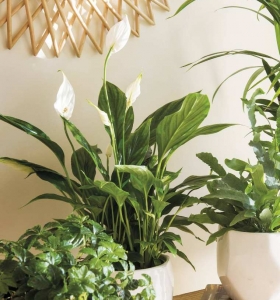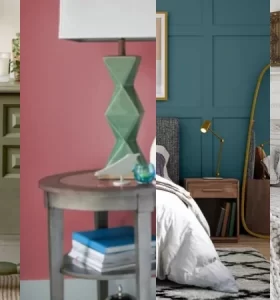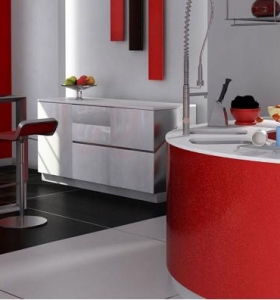Wabi sabi – Cómo abrazar la belleza de la imperfección en el diseño
Wabi sabi – Cómo abrazar la belleza de la imperfección en el diseño
El concepto de wabi sabi ha estado ganando popularidad en el mundo del diseño en los últimos años. Originario de Japón, el wabi sabi es una filosofía que celebra la belleza de la imperfección y la simplicidad en todos los aspectos de la vida, incluido el diseño.
En un mundo obsesionado con la perfección y la estandarización, el wabi sabi nos invita a apreciar la singularidad y la autenticidad de todo lo que nos rodea. En lugar de buscar la uniformidad, el wabi sabi busca resaltar las marcas del tiempo y las imperfecciones que hacen que cada objeto sea único.
En el diseño, el wabi sabi nos anima a utilizar materiales naturales y a dejar que muestren su verdadera esencia. El desgaste, las grietas y las irregularidades no son considerados defectos, sino características que añaden belleza y valor a un objeto. Al utilizar elementos imperfectos, creamos diseños con alma y personalidad, rechazando la estandarización y la artificialidad.
El wabi sabi también promueve la simplicidad y la sobriedad en el diseño. En lugar de añadir elementos superfluos, se busca la esencia y se elimina todo lo innecesario. Esto no solo crea diseños más armoniosos, sino que también nos permite apreciar la belleza de la sutileza y la simplicidad.
Además, el wabi sabi nos invita a abrazar el paso del tiempo y la impermanencia. En lugar de buscar diseños duraderos, el wabi sabi aprecia la belleza efímera y transitoria. Un objeto que muestra los estragos del tiempo nos recuerda la inevitable naturaleza cambiante de todo lo que nos rodea, y nos invita a apreciar cada momento y cada etapa de nuestra vida.
Aplicar el wabi sabi en el diseño implica cambiar nuestra forma de pensar y de ver el mundo. Nos invita a dejar de lado los estándares de belleza convencionales y a apreciar la belleza en lo cotidiano y lo imperfecto. Nos anima a buscar la autenticidad en lugar de la perfección y a valorar la simplicidad en lugar de la complejidad.
En resumen, el wabi sabi es una filosofía que nos enseña a abrazar la belleza de la imperfección en el diseño. Nos invita a apreciar la singularidad y la autenticidad de cada objeto, a utilizar materiales naturales y a buscar la simplicidad en lugar de la complejidad. Al aplicar el wabi sabi en el diseño, creamos objetos con alma y personalidad, y aprendemos a apreciar la belleza efímera y transitoria de todo lo que nos rodea. En resumen, el wabi sabi nos enseña a encontrar belleza en las cosas imperfectas y a abrazar la simplicidad y la sutileza en el diseño. Nos anima a valorar la autenticidad y la singularidad en lugar de la uniformidad y la artificialidad. Al aplicar el wabi sabi en el diseño, creamos objetos con alma y personalidad, y cultivamos una apreciación por la belleza efímera y transitoria de todo lo que nos rodea. El wabi sabi nos invita a cambiar nuestra perspectiva y a apreciar la belleza en lo imperfecto y lo efímero. Nos enseña a valorar la autenticidad y la singularidad, y a buscar la simplicidad en lugar de la complejidad. Al abrazar esta filosofía en el diseño, creamos objetos con alma y personalidad, y cultivamos una apreciación por la belleza en todas sus formas. El wabi sabi es una filosofía que nos invita a apreciar la belleza de la imperfección, la simplicidad y la autenticidad en el diseño. En lugar de buscar la perfección y la estandarización, el wabi sabi busca resaltar las marcas del tiempo y las imperfecciones que hacen que cada objeto sea único. Esto se logra utilizando materiales naturales y permitiendo que muestren su verdadera esencia, aceptando el desgaste, las grietas y las irregularidades como características que añaden belleza y valor al objeto.
Además, el wabi sabi promueve la simplicidad y la sobriedad en el diseño, eliminando elementos superfluos y buscando la esencia de cada objeto. Esta simplicidad no solo crea diseños más armoniosos, sino que también nos permite apreciar la belleza de la sutileza y la simplicidad en sí mismas.
Otro aspecto importante del wabi sabi es la apreciación del paso del tiempo y la impermanencia. En lugar de buscar diseños duraderos, el wabi sabi valora la belleza efímera y transitoria. Un objeto que muestra los estragos del tiempo nos recuerda la naturaleza cambiante de todo lo que nos rodea y nos invita a apreciar cada momento y cada etapa de nuestra vida.
Aplicar el wabi sabi en el diseño implica cambiar nuestra forma de pensar y de ver el mundo. Nos anima a dejar de lado los estándares de belleza convencionales y a apreciar la belleza en lo cotidiano y lo imperfecto. Nos invita a buscar la autenticidad en lugar de la perfección y a valorar la simplicidad en lugar de la complejidad.
En resumen, el wabi sabi nos enseña a abrazar la belleza de la imperfección en el diseño, apreciando la singularidad, la autenticidad, la simplicidad y la efimeridad. Al aplicar esta filosofía en el diseño, creamos objetos con alma y personalidad, y cultivamos una apreciación por la belleza en todas sus formas. El wabi sabi nos invita a cambiar nuestra perspectiva y a encontrar belleza en lo imperfecto y lo efímero. Nos enseña a valorar la autenticidad y la singularidad, y a buscar la simplicidad en lugar de la complejidad. Al abrazar esta filosofía en el diseño, creamos objetos con alma y personalidad, y cultivamos una apreciación por la belleza en todas sus formas. En resumen, el wabi sabi es una filosofía que nos enseña a apreciar la belleza de la imperfección en el diseño. Nos invita a valorar la autenticidad y la singularidad en lugar de la uniformidad y la artificialidad. Al abrazar esta filosofía en el diseño, creamos objetos con alma y personalidad, y cultivamos una apreciación por la belleza en todas sus formas.

In a world that constantly strives for perfection in every aspect of life – the perfect home, the perfect family, the perfect job – we find ourselves caught in a never-ending pursuit of more. But what if we took a moment to embrace the ancient Japanese philosophy of wabi sabi? Could we free ourselves from the need for a perfect life and instead find contentment in the imperfect beauty that surrounds us? Let’s explore how wabi sabi can transform our interior designs into something truly captivating.
Embracing the Beauty of Imperfection in Interior Design

Perhaps you’re constantly buying new items, yet your space never seems complete. Or maybe you’ve previously strived for a minimalist lifestyle, but now crave a cozy atmosphere in your living room. Whatever your story may be, embracing a wabi sabi-inspired way of life could make your home feel a little cozier and, above all, a little more like home.

Wabi Sabi: Imperfection is Beauty
So, what exactly is wabi sabi? Rooted in Zen Buddhism, wabi sabi is an ancient Japanese concept centered around accepting and embracing the imperfections that surround us. It’s about recognizing the flaws and the transient nature of life, and appreciating the beauty of the natural world and all that it entails.

Wabi sabi can be found in many aspects of our lives, from our relationships with ourselves and others, to the joy of freshly prepared food, and the love for family heirlooms, whether it be a piece of clothing or a rustic piece of furniture.

Wabi Sabi Interior Design
When it comes to our homes, wabi sabi cannot be bought in material possessions. Wabi sabi can be found in the quirky details of antique dishware, in handmade furniture that is unique to your home, and in natural materials like wood and stone. With so much emphasis placed on updating our homes with new possessions, new trends, and new styles, we often find ourselves pressured to keep our homes in perfect condition.

However, by channeling wabi sabi and embracing imperfection in all our interiors, we can create harmonious and lived-in spaces that are both cozy and modern. We can’t deny the fact that sometimes we simply need to buy new things, but if you approach these purchases with wabi sabi in mind, you’ll find yourself investing in sustainable materials and unique pieces that stand the test of time.

Today, we share with you our take on the ancient Japanese philosophy and how it is used in wabi sabi-inspired home design. “Wabi-sabi” is a Japanese term that means finding beauty in imperfection. Wabi refers to living with humility and simplicity, while being one with nature, while sabi is defined as the ability to accept the life cycle of anything as it is: flaws and all.

<h3 style=](https://casaydiseno.com/wp-content/uploads/2018/08/dormitorio-amplio-opciones-originales-diseno-atractivo.jpg) Getting Back to Basics
Getting Back to Basics
A wabi-sabi sensibility is one that keeps possessions to a minimum by inviting only those things that bring nostalgia, beauty, utility, or a combination of all of that. Once again, this trend doesn’t use minimalism for the sake of minimalism, but rather aims to keep things that are essential for a calm and happy spirit in order to maximize the joy of everyday life.

Unlike a minimalist enthusiast who might get rid of a vase they like but doesn’t fit their aesthetic, a lover of wabi-sabi design will keep that vase simply because it makes them happy.

Furniture
Things in Wabi-Sabi interiors don’t appear accidentally and must meet certain requirements:
– Be imperfect, with some flaws;
– Be simple and create a harmonious design.

Wabi-sabi is similar to rustic European interior style. And some items can be taken from it, just leave them covered not with paint, but with matte varnish.
Some furniture can be borrowed from vintage style, for example, metal structures with patina or rust, simple accessories in shape.

Textiles
Fabrics and textiles are similar to those used in Scandinavian interiors. Choose the thickest and simplest ones, in a natural color scheme.

Lighting
The philosophy of lighting the interior designed in Wabi-Sabi style is similar to Scandinavian style: soft, dim, and diffused light. This Wabi-Sabi approach is inspired by the lighting of the Japanese tea house – tsuitsu – which has specially built windows on the north side. Trees grow next to the windows, further dispersing the light.

Storage
It is unacceptable for a interior of this type to have a plasma TV or a computer in plain sight, which should be better hidden. The computer will have to be replaced with a laptop that is easy to clean and store after work.

Request a built-in wardrobe to the maximum height of the wall. As facades, you can take rough boards. Inside, there will be storage space and a retractable TV. If the area allows, you can make a separate pantry, which inside can be quite modern.

Originality over Superficiality
Here, there is noWabi-Sabi: Embracing the Beauty of Imperfection in Interior Design
Wabi-Sabi is all about respecting traditions while embracing your own unique design sensibility. It’s about creating a tranquil design that is infused with the elegance of nature and the understated beauty of imperfection.
Think of vintage furniture that has aged beautifully, with a gorgeous patina, or a lime-washed wall that has started to peel. These elements add character to your space and tell their own stories.
Whether your style is rustic, modern, or mid-century classic, don’t hesitate to invest in pieces that celebrate and showcase the test of time they have endured.
Tip: Avoid shiny, super smooth, or highly polished finishes or textures in this space. Instead, opt for vintage-inspired materials that exude a sense of serenity and beauty.
Wabi-Sabi: An Ode to Nature and Sustainability
Respecting the natural world and what it offers is essential to the Wabi-Sabi way of life. Before discarding anything, think twice and reimagine the piece or find a way to repurpose it.
Consider the impact that unnecessary waste has on our ecosystem. Take a trip to your local thrift store or second-hand furniture market and look for pieces that can be restored.
Take a look at the photos shown here, where designers have used reclaimed wood as a clever accent wall. Beautiful old traditional doors can also be repurposed as headboards or room dividers. In all designs, the focus is on preserving authenticity and working with the right materials.
Depending on the use, don’t forget to use reclaimed wood to achieve an almost natural look or cover it with a durable polyurethane that will form a protective barrier over the original surface while adding a subtle shine. You can also draw inspiration from nature for various shades of brown, beige, white, and gray.
Wabi-Sabi is about recognizing that beauty only improves with time and the subsequent wear and tear of objects. Whether you purchase a brass lamp or invest in a set of copper containers, these pieces have the quality of aging gracefully over time, oxidizing and changing color to display a unique patina.
Did you know? A Japanese practice that focuses on recycling pieces that may have been accidentally broken or chipped is the art of Kintsugi or golden joinery.
Kintsugi, as an art form, recognizes repair and breakage as part of an object’s history, rather than disguising it. Broken ceramics are mended with gold, highlighting the cracks and making them a beautiful part of the piece’s story.
Incorporating Wabi-Sabi into your interior design allows you to create a space that is not only visually appealing but also deeply connected to nature and sustainability. Embrace imperfections, celebrate the passage of time, and let the beauty of Wabi-Sabi transform your home.
In recent years, we have seen design trends following Scandinavian concepts for a cozy and balanced home. But now, the conversation has shifted, looking eastward for some inspiration. We hope you have embraced the Japanese philosophy that embraces everything imperfect and impermanent.
Don’t forget that this is the design and lifestyle trend of the year, and with the values that wabi sabi offers, it has come to stay in the hearts of those who want to decorate their homes with pieces that are made to last.






